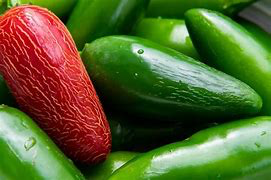“To grow a tomato or a pepper and prepare a meal from your labor is primordially satisfying” — Nell Newman
Peppers can be differentiated by amount of “heat” they contain: the level of the chemical capsaicin. Bell peppers are sweet tasting and lack the spiciness while other varieties contain various levels of the chemical
“capsaicin” which creates the perceived heat.
• The level of capsaicin is represented on the Scoville Scale as shown at right:
NOTE: Food banks request that donated peppers of any variety be clearly labeled as to their degree of heat: mild, medium, hot, very hot.
Benefits and nutritional information:
- Most peppers are very high in Vitamin C, a red bell pepper providing 170% RDI.
- Those with capsaicin are described as boosting metabolism while reducing appetite, potentially making it easier to lose weight.
Starting
- Peppers need warm soil temperatures for germination and growth. Since those conditions don’t happen naturally until later in our growing season, we have to plant peppers from seedlings — either from a commercial nursery or from our own indoor
- It is possible to keep a pepper plant going from one year to the next. They need to be cut back by about 2/3rds and provided with protection against freezing weather.
When to plant:
- Moving peppers from a warmer to a cooler setting require hardening off to ensure their survival.
- Since peppers are native to warmer regions, we in the Pacific Northwest have to put a bit more effort into growing them.
- Soil temperature is a big determinant of success or failure.
- Plant peppers seedlings deep enough so the bottom set of leaves on the stem is just above the soil level. This helps them grow better because they form roots all along any buried portion of the stem.
Thinning, training:
- Pepper plants should be generally spaced 18 inches apart in rows 30 to 36 inches apart.
- Peppers of different varieties should planted even further apart since cross pollination can result in some unwanted results: red bell peppers with a bite of capsaicin or bland jalapeños.
- Peppers are easily damaged when laden with fruit. For support, tie the plants to stakes using old nylons, which have some 'give' as the stems enlarge.
- Don't use wire twist-ties or twine which will gradually choke off or even snap the stem.
Signs of overwatering, nutrient deficiency:
- Peppers don’t tolerate dry soils, but neither do they tolerate overly wet ones.
- Corking on peppers appears as scaring or minor striations on the surface of the pepper skin. When you see jalapeño skin cracking in this manner, it simply means that it needs to stretch to accommodate the rapid growth of the pepper. Sudden rains or any other abundance of water (soak
 er hoses) combined with plenty of sun will cause the pepper to go on a growth spurt, resulting in corking. This corking process occurs in many types of hot peppers, but not in sweet pepper varieties.
er hoses) combined with plenty of sun will cause the pepper to go on a growth spurt, resulting in corking. This corking process occurs in many types of hot peppers, but not in sweet pepper varieties. - Working compost into the soil can provide peppers with the right amount of soil moisture.
- Peppers also require a balanced fertilizer.
- A high level of nitrogen in the soil will result in a plant with lush foliage but not fruit.
Pests and pest controls:
- Peppers are subject to several diseases: Mosaic virus, Verticillium wilt and blight.
- Aphids are predatory plus help spread mosaic virus.
- Cutworms and flea beetles
Harvesting
- Peppers are ready to pick when a gentle tug releases the fruit.
Other resources and articles
What can I plant next to jalapeno peppers? For jalapeno papers, the bets companion plants include the following:
- Carrots
- Marjoram
- Peppers
- Parsley
- Chives
- Oregano
- Coriander
- Dill
- Garlic
- Asparagus
- Eggplants
- Cucumbers
- A lot of the companion plants for other peppers are also available for the jalapenos.
What not to plant with peppers. The plants to never plant close to all types of peppers are as follows:
- Beans (for jalapenos)
- Peas (for jalapenos)
- Cauliflower
- Kohlrabi
- Broccoli
- Cabbage
- Kale
- Brussels sprouts
- Fennel
- These plants are harmful to the peppers in different ways. Some compete with the peppers for similar soil nutrients while others attract pests and diseases which may affect the peppers.

 er hoses) combined with plenty of sun will cause the pepper to go on a growth spurt, resulting in corking. This corking process occurs in many types of hot peppers, but not in sweet pepper varieties.
er hoses) combined with plenty of sun will cause the pepper to go on a growth spurt, resulting in corking. This corking process occurs in many types of hot peppers, but not in sweet pepper varieties.